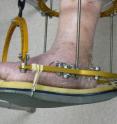New treatment for crippling diabetic Charcot foot
The alarming increase of morbidly obese diabetics is causing more new cases of a debilitating foot deformity called Charcot foot. Charcot foot can make walking difficult or impossible, and in severe cases can require amputation.
But a surgical technique that secures foot bones with an external frame has enabled more than 90 percent of patients to walk normally again, according to Loyola University Health System foot and ankle surgeon Dr. Michael Pinzur. Pinzur, one of the nation's leading surgeons who treat Charcot foot, describes the device in the journal Hospital Practice.
The device, called a circular external fixator, is a rigid frame made of stainless steel and aircraft-grade aluminum. It contains three rings that surround the foot and lower calf. The rings have stainless-steel pins that extend to the foot and secure the bones after surgery.
The fixator "has been demonstrated to achieve a high potential for enhanced clinical outcomes with a minimal risk for treatment-associated morbidity," Pinzer wrote. Pinzur treats about 75 Charcot patients per year with external fixators. Most of these patients are diabetics.
Charcot foot can occur in a diabetic who has neuropathy (nerve damage) in the foot that impairs the ability to feel pain. Charot foot typically occurs following a minor injury, such as a sprain or stress fracture. Because the patient doesn't feel the injury, he or she continues to walk, making the injury worse. Bones fracture, joints collapse and the foot becomes deformed. The patient walks on the side of the foot and develops pressure sores. Bones can become infected.
The obesity epidemic is increasing the incidence of Charcot foot in two ways. The excess weight increases the risk of diabetic neuropathy, as well as the risk that patients with diabetic neuropathy will develop Charcot foot.
There has been an alarming increase in morbid obesity among diabetics. About 62 percent of U.S. adults with Type 2 diabetes now are obese, and 21 percent are morbidly obese, according to a 2009 study by Loyola kidney specialist Dr. Holly Kramer and colleagues published in the Journal of Diabetes and its Complications.
Morbid obesity is defined as having a body mass index (BMI) greater than 40. For example, a person who is 5-foot, 10-inches tall and has a BMI of 40 weighs 278 pounds.
Traditional surgical techniques, in which bones are held in place by internal plates and screws, don't work with a subset of obese Charcot patients. Their bones, already weakened by complications of Charcot foot, could collapse under the patient's heavy weight.
A common treatment in such cases is to put the patient in a cast. But bones can heal in deformed positions. And, it is difficult or impossible for obese patients to walk on one leg when the other leg is in a cast. Patients typically have to use wheelchairs and are confined to the first story of the house for as long as nine months. And after the cast comes off, they must wear a cumbersome leg brace.
By contrast, patients who are treated with an external fixator often are able to walk or at least bear some weight on the treated leg. The device is attached to the leg for only two or three months.
A 2007 study by Pinzer, published in Foot & Ankle International, demonstrated the benefits of the external fixator. Pinzur followed 26 obese, diabetic Charcot foot patients who had an average body mass index of 38.3. After surgery to correct the deformity, the foot bones were held in place by the external fixator. A year or more later, 24 of the 26 patients (92 percent) had no ulcers or bone infections and were able to walk without braces, wearing commercially available shoes designed for diabetics.
Pinzur is a professor in the Department of Orthopaedic Surgery and Rehabilitation at Loyola University Chicago Stritch School of Medicine.
Source: Loyola University Health System
Other sources
- New treatment for crippling diabetic Charcot footfrom Science DailyFri, 16 Jul 2010, 4:35:27 UTC
- New treatment for crippling diabetic Charcot footfrom PhysorgWed, 14 Jul 2010, 8:35:25 UTC
- New treatment for crippling diabetic Charcot footfrom Science BlogWed, 14 Jul 2010, 6:14:12 UTC
